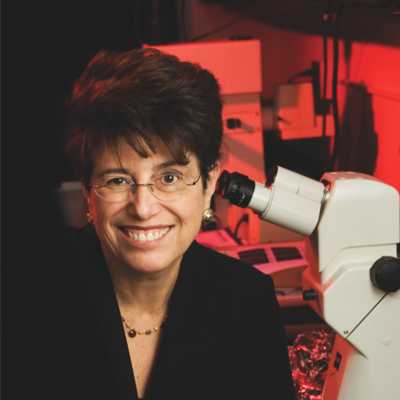Treating demyelinating diseases
Myelin is the body’s insulator for neurons that allows messages in the body to be relayed quickly and effectively. Often, if myelin breaks down, for instance as we age or when disease occurs, cognitive functioning or physical functioning slows. Such is the case for patients with Multiple Sclerosis (MS) and Alzheimer’s disease, who, as a result, lose their ability to walk or remember the past. Dr. Cheryl Dreyfus, Professor and Chair of Neuroscience and Cell Biology at Rutgers Robert Wood Johnson Medical School is searching for an approach that would reverse the devastation associated with MS and Alzheimer’s disease. Having devoted her professional career to this cause, in recent years, Dr. Dreyfus has identified small molecules that have the ability to pass the blood-brain barrier and that may reverse some of the deficits associated with the diseases.
Dr. Dreyfus’ lab was among the first, some years ago, to find that BDNF, a specific growth factor, can impact the ability of the cells that create myelin, and thus potentially reverse the lesions that cause disease. In fact, by increasing BDNF, Dr. Dreyfus found that cells could reverse aspects of a demyelinating lesion. Furthermore, recent results indicate that a specific neurotransmitter simulator may play a protective role in MS models of brain disease. Therefore, by understanding the mechanisms underlying disease, Dr. Dreyfus and her team hope to find a treatment that can reverse the effects of MS and Alzheimer’s disease.
Current research includes:
-
Repairing Myelin Damage: Current work is focused on understanding how to increase the release of BDNF from cells in the brain to the spinal cord in order to repair myelin damage for patients with MS. In preliminary work, she and her team have found that in two separate models of MS, events associated with demyelination may be impacted.
- Alzheimer’s Disease: Future studies hope to apply the same methods to treating Alzheimer’s disease. Because some of the same mechanisms are associated with both MS and Alzheimer’s, Dr. Dreyfus believes that her research may make an impact on patients with Alzheimer's as well.
Bio
When Dr. Cheryl Dreyfus first began conducting research as a master’s student, she caught sharks to study their reproductive systems. While she found this exciting and fun, when people asked why the work was relevant, it was hard to find a reasonable answer. Dr. Dreyfus realized then that if she was going to become a scientist, she wanted to do something that she believed would make a difference in people’s lives one day. Therefore, she applied to Ph.D. programs at medical schools where she found, to her delight, that she loved doing research.
Because her goal was not only to do research, but also to discover something that might help others, she began to study the nervous system. In her initial work, she was directed to learn to grow cells in a culture dish. A little disappointed that her project wasn’t broader in scope, it was explained to her that the brain is a complex place and to understand factors that might affect cells, she had to begin using simple models.
While using these models, she fortunately found herself in a laboratory directed by a neurologist who specialized in treating patients with Multiple Sclerosis. Dr Dreyfus’ research was not to study that disease, but she met many patients who had Multiple Sclerosis and was struck by the tragedy of MS that often attacks people of her very age at that time who were beginning to pursue their independent lives. This influenced her as she began the pursuit of her own research and stumbled upon the observation in culture that the very cells, called oligodendrocytes, that are injured in MS patients, could be encouraged to divide and mature when treated with a growth factor called BDNF. Interestingly, these are cells that are also injured in patients with Alzheimer’s disease. Dr Dreyfus’ goal became to increase the BDNF in order to help patients with these diseases someday. Interestingly, it has been found that indeed, BDNF is decreased in those patients and thus increasing it may be a viable treatment. Dr. Dreyfus’ current work is beginning to identify small molecules that can cross the blood-brain barrier and increase BDNF in the brain.
While Dr. Dreyfus takes her roles as scientist, teacher, and chair of her department seriously, her role as a mother and wife has also been extraordinarily important. While her children are grown now, as a mom and a wife, she cherishes her time with her family. She also has a grandson with whom she Skypes with often as he lives in California. Her children, husband, and now grandson have all become quite knowledgeable about BDNF and its various functions.


